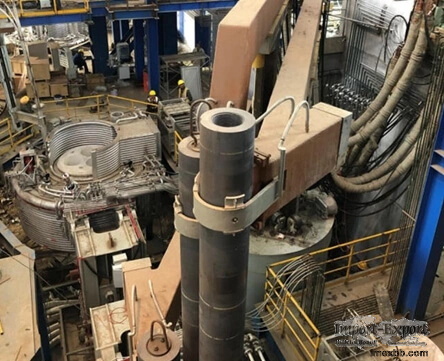 |
 |
Home > Offers to Sell > Electronics & Electrical > Passive Components > Acoustic Components
| Contact: | chnzb |
|---|---|
| Company: | CHNZBTECH Co.,Ltd. |
| 25th Floor, Silk Road Center, International Port Area, Baqiao District, XI'AN. | |
| XI'AN 710005 | |
| China | |
| Phone: | JustinKzao.zbmetaltech@gmail.c |
| E-Mail: | |
| Date/Time: | 10/24/23 6:30 GMT |
Secondary Refining Furnace
The steel refining process by secondary refining furnace can be divided into
two categories: primary refining, aimed at removing carbon from pig iron, and
additional refining processes conducted after primary refining, collectively
referred to as secondary refining. Secondary refining furnace process involves
the removal of impurities and adjustment of elements. The secondary refining
usually takes place in a ladle (a transport container for molten steel) and is
crucial for producing high-quality steel. The primary role of secondary
refining is ultimate desulfurization, the elimination of oxygen, nitrogen,
hydrogen, and other impurities, as well as the final decarburization of ultra-
low carbon steel.
A steel melting and secondary refining method comprising the steps of melting
steel manufacture raw materials while the molten steel is subjected to
oxidation and decarburization so that the oxidation and decarburization are
substantially completed before melt-down; after melt-down, heating the molten
steel to a temperature above a liquidus line temperature and below 50℃. in
temperature increment from the liquidus line temperature, and thereafter
tapping the molten steel into a primary ladle; teeming the molten steel from
the primary ladle into a secondary refining furnace; allowing the molten steel
to be effluent into a secondary ladle at a lower portion of the secondary
refining furnace while the temperature of the molten steel is raised; and
continuously performing gas bubbling in the secondary ladle in a vacuum under
existence of slag simultaneously with the effluence of the molten steel into
the secondary ladle.
TYPES OF SECONDARY REFINING FURNACE
In the realm of steel production, the Secondary Refining Furnace stands as a
pivotal player in achieving exceptional steel purity and quality. This crucial
phase of the secondary metallurgy steelmaking process encompasses various
techniques aimed at fine-tuning the composition of the molten metal,
eliminating impurities, and ensuring the final product meets the stringent
demands of modern industries.
WHAT ARE THE FUNCTIONS OF VARIOUS SECONDARY REFINING FURNACES?
Advantages of ladle refining furnace in alloy steel secondary refining
Enhancing Steel Quality through ESR Process
Stainless steel refining: AOD and VOD furnace
Advantages of ladle refining furnace in alloy steel secondary refining
Ladle refining furnace offers strong heating functions, permits the addition of
a large amount of alloys, and enables precise temperature control. The ladle
secondary refining furnace also provides outstanding desulfurization by high-
temperature treatment with reducing fluxes and the removal of deoxidation
products. The LRF process is therefore often used for the secondary refining
process of alloy steel.
THE PIVOTAL ROLE OF SECONDARY REFINING FURNACES-SHAPING MODERN STEEL EXCELLENCE
Secondary refining aims to fine-tune the steel's properties, ensuring the
secondary refining process meets the stringent requirements of various
industries, including automotive, construction, aerospace, and more.
Purity Enhancement: Steel produced in primary lead refining furnace can still
contain impurities and non-metallic inclusions that might adversely affect its
mechanical properties, formability, and overall quality. Secondary refining
furnaces, such as ladle furnaces or vacuum degassing units, focus on reducing
these impurities to enhance the steel's purity. Through secondary refining
processes like desulfurization and deoxidation, excess sulfur and oxygen are
removed, leading to cleaner and more refined steel.
Composition Adjustment: Steel's composition can significantly impact its
performance in various applications. Secondary refining furnaces provide a
controlled environment for adjusting the composition of steel by adding precise
amounts of alloying elements. This secondary metallurgy steelmaking process
allows steelmakers to achieve specific mechanical properties, corrosion
resistance, and other characteristics required for specific applications.
Refining Quality: The secondary refining process involves precise temperature
and chemical control, which aids in the removal of undesirable elements and
compounds that could compromise the steel's quality. By utilizing techniques
like argon or vacuum degassing, hydrogen removal, and slag foaming, steelmakers
can achieve higher levels of cleanliness and homogeneity in the final product.
This contributes to improved mechanical properties, surface finish, and overall
quality.
FAQS ABOUT SECONDARY REFINING FURNACE
HOW DOES A SECONDARY REFINING FURNACE ENHANCE THE PURITY OF STEEL?
Secondary refining furnaces employ various processes to enhance the purity of
steel. Through the flow of molten steel, these furnaces can remove excess
sulfur, oxygen, and other impurities using techniques such as blowing,
injection, or vacuum treatment. This treatment significantly reduces the
content of non-metallic inclusions and impurities, resulting in cleaner and
higher purity steel.
HOW DO SECONDARY REFINING FURNACES CONTRIBUTE TO ENVIRONMENTAL SUSTAINABILITY?
Modern secondary refining furnaces also take environmental factors into
consideration. They utilize technologies such as slag recycling and waste heat
utilization to reduce waste generation, energy consumption, and emissions.
These measures contribute to achieving sustainable steel production and
reducing the environmental impact.
HOW DO SECONDARY REFINING FURNACES ADJUST THE COMPOSITION OF STEEL TO MEET
SPECIFIC REQUIREMENTS?
Secondary refining furnaces adjust the composition of steel by adding alloying
elements to meet specific requirements. Steel producers can precisely control
the amount of alloying elements added, thus achieving specific properties and
characteristics in the steel, such as corrosion resistance, thermal
conductivity, hardness, etc. This enables steel to be tailored for various
application domains.
For more information about furnace in steel plant and cupellation furnace
price, please feel free to contact us!
SOURCE: Import-Export Bulletin Board (https://www.imexbb.com/)
Similar Products:Not exactly what you are looking for? Post an Offer to Buy!
![]()
© 1996-2010 IMEXBB.com. All rights reserved.
|
|
|





